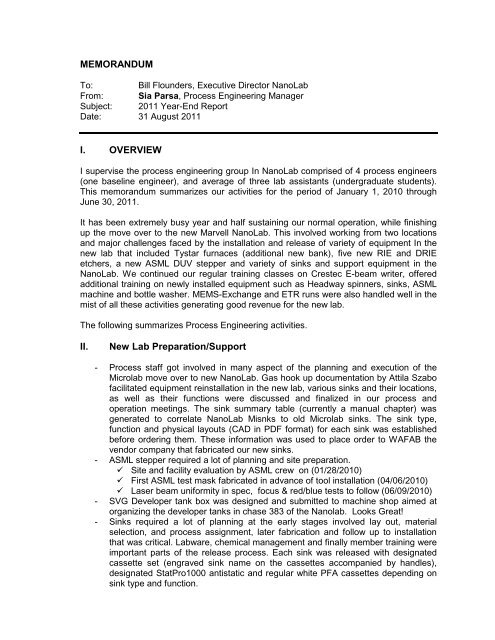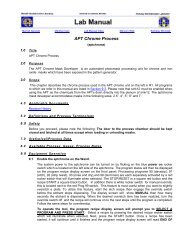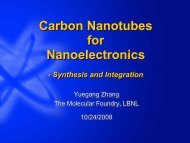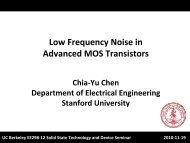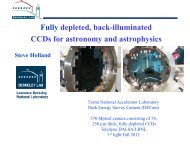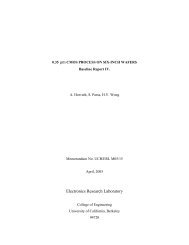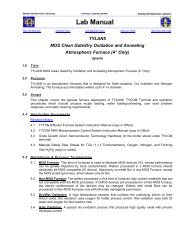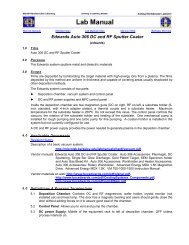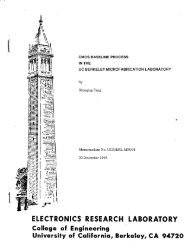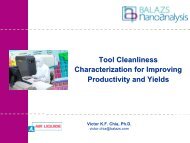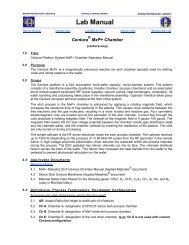Sia Parsa - Berkeley Microlab
Sia Parsa - Berkeley Microlab
Sia Parsa - Berkeley Microlab
Create successful ePaper yourself
Turn your PDF publications into a flip-book with our unique Google optimized e-Paper software.
MEMORANDUM<br />
To: Bill Flounders, Executive Director NanoLab<br />
From: <strong>Sia</strong> <strong>Parsa</strong>, Process Engineering Manager<br />
Subject: 2011 Year-End Report<br />
Date: 31 August 2011<br />
I. OVERVIEW<br />
I supervise the process engineering group In NanoLab comprised of 4 process engineers<br />
(one baseline engineer), and average of three lab assistants (undergraduate students).<br />
This memorandum summarizes our activities for the period of January 1, 2010 through<br />
June 30, 2011.<br />
It has been extremely busy year and half sustaining our normal operation, while finishing<br />
up the move over to the new Marvell NanoLab. This involved working from two locations<br />
and major challenges faced by the installation and release of variety of equipment In the<br />
new lab that included Tystar furnaces (additional new bank), five new RIE and DRIE<br />
etchers, a new ASML DUV stepper and variety of sinks and support equipment in the<br />
NanoLab. We continued our regular training classes on Crestec E-beam writer, offered<br />
additional training on newly installed equipment such as Headway spinners, sinks, ASML<br />
machine and bottle washer. MEMS-Exchange and ETR runs were also handled well in the<br />
mist of all these activities generating good revenue for the new lab.<br />
The following summarizes Process Engineering activities.<br />
II. New Lab Preparation/Support<br />
- Process staff got involved in many aspect of the planning and execution of the<br />
<strong>Microlab</strong> move over to new NanoLab. Gas hook up documentation by Attila Szabo<br />
facilitated equipment reinstallation in the new lab, various sinks and their locations,<br />
as well as their functions were discussed and finalized in our process and<br />
operation meetings. The sink summary table (currently a manual chapter) was<br />
generated to correlate NanoLab Misnks to old <strong>Microlab</strong> sinks. The sink type,<br />
function and physical layouts (CAD in PDF format) for each sink was established<br />
before ordering them. These information was used to place order to WAFAB the<br />
vendor company that fabricated our new sinks.<br />
- ASML stepper required a lot of planning and site preparation.<br />
Site and facility evaluation by ASML crew on (01/28/2010)<br />
First ASML test mask fabricated in advance of tool installation (04/06/2010)<br />
Laser beam uniformity in spec, focus & red/blue tests to follow (06/09/2010)<br />
- SVG Developer tank box was designed and submitted to machine shop aimed at<br />
organizing the developer tanks in chase 383 of the Nanolab. Looks Great!<br />
- Sinks required a lot of planning at the early stages involved lay out, material<br />
selection, and process assignment, later fabrication and follow up to installation<br />
that was critical. Labware, chemical management and finally member training were<br />
important parts of the release process. Each sink was released with designated<br />
cassette set (engraved sink name on the cassettes accompanied by handles),<br />
designated StatPro1000 antistatic and regular white PFA cassettes depending on<br />
sink type and function.
III. TRANSFERRED AND NEW EQUIPMENT INSTALLATION IN NANOLAB<br />
Process staff generated on-line manuals for newly installed & transferred equipment in the<br />
NanoLab, also evaluated and released standard processes on baseline tools, helped<br />
members continue their process on other equipment in the lab. These activities involved<br />
release of standard recipes on Lam etcher, Tystar furnaces, as well as stepper jobs for<br />
ASML and GCAWS steppers. Matt Wasilik our BSAC engineer helped us release<br />
standard etch processes on the new DRIE STS machines. He worked with graduate<br />
students (Fabian Goerick) to qualify aluminum nitride deposition process in our newly<br />
installed AlN machine, also helped us release flip chip bonder, Ks aligner and KS bonder<br />
in the new lab.<br />
ASML stepper 5500/300 (new tool)<br />
Careful site preparation and planning was warranted in the installation of our new DUV<br />
5500/300 ASML stepper in the NanoLab. Preemptive evaluation of in-house mask making<br />
capability was also important, lack of which could have impacted the cost of operation<br />
dramatically.<br />
Mask generation: A four field mask was fabricated and forwarded to ASML application<br />
engineers to try at IBM San Jose. This was done prior to our stepper arrival to foresee<br />
possible mask making issues that needed to get addressed before the arrival of our new<br />
ASML 5500/300 model stepper (5/3/10).<br />
Training: Two Training sessions were offered to retrain qualified users of the previous<br />
model stepper (5500/90) on the new 5500/300 model (01/06/2011 and 01/12/2011).<br />
Process staff also helped members redesigned their mask onto the new 4X template<br />
currently posted on line, all went extremely well thanks to everyone’s cooperation.<br />
Lens Qualification: A critical part of the stepper site acceptance involved Lens<br />
Qualification test. A complex array of features were printed and measured to rule out<br />
possible lens damage and/or inherent lens problems. ASML needed to demonstrate good<br />
process window for this particular 5500/300 stepper by meeting their specification in<br />
regards to Useable Depth of Focus (UDOF) and Critical Dimension (CD) Uniformity. This<br />
test was initiated after the stepper had gone through its initial setup/qualification and<br />
stabilized for sometimes, as a final step in the overall stepper acceptance process in<br />
NanoLab. Lens qualification utilizes focus exposure matrix (FEM) to determine Useable<br />
Depth of Focus (UDOF) and Critical Dimension (CD) Uniformity through generation of<br />
Bossung curves (spider plot or smiley plots) shown in Figure1 below. Their automated<br />
SEM was used to measure critical dimensions (CD) of printed vertical/horizontal 0.25 µm<br />
test features shot at different focus and exposure settings by the FEM procedure. The CD<br />
values that fell within specified range (0.25 µm + 10%) were summarized in Table -1.<br />
These data were then used to generate the Bossung curves (spider plot or smiley plots) in<br />
Figure 1. Useable Depth of Focus (UDOF) = 1.1 µm (specification > 0.7 µm) and Critical<br />
Dimension (CD) Uniformity Range = 20 nm (specification < 30 nm) were demonstrated by<br />
the lens qualification all within spec. Please note data outside 0.25 µm + 10% CD range<br />
were rejected as out of spec data, hence were not shown in Table1.
CD (mm)<br />
0.400<br />
0.350<br />
0.300<br />
0.250<br />
0.200<br />
0.150<br />
0.100<br />
1.50<br />
Table 1- FEM test results for lens qualification test (X= energy and Y=focus)<br />
SEM measurement data (CD's) were then plotted in figure 1 to show this particular lens<br />
met specified CD uniformity and focus requirement of the lens qualification test.<br />
1.40<br />
1.30<br />
1.20<br />
1.10<br />
1.00<br />
0.90<br />
0.80<br />
0.70<br />
0.60<br />
0.50<br />
m UCB 5500/ 300B @ 0.25 um Nominal CD<br />
0.40<br />
0.30<br />
NA 0.57 Sigma 0.75/<br />
0.20<br />
0.10<br />
0.00<br />
Focus (mm)<br />
Figure 1- Bossung curves, CD variation as a function of focus and exposure energy<br />
-0.10<br />
-0.20<br />
-0.30<br />
-0.40<br />
-0.50<br />
-0.60<br />
-0.70<br />
-0.80<br />
-0.90<br />
-1.00<br />
-1.10<br />
-1.20<br />
-1.30<br />
-1.40<br />
-1.50<br />
0V<br />
1H<br />
1V<br />
2H<br />
2V<br />
3H<br />
3V<br />
4H<br />
4V<br />
5H<br />
5V<br />
6H<br />
6V<br />
7H<br />
7V<br />
8H<br />
8V
Software Upgrade: Request was made of the ASML application manager to explore<br />
possibility of installing all the available software options on our ASML 5500/300 stepper.<br />
This took a while and fortunately ASML upper management graciously agreed to have all<br />
additional available options that did not originally come with the tool installed, listed<br />
below.<br />
9428.999.75780 - Test Streaming UF<br />
9428.999.67050 - 3" Handling UF<br />
9428.999.79100 - Thickness range offset UF<br />
9428.999.62310 - Job creator UF<br />
9428.999.62500 - Focus spot monitor UF<br />
9428.999.76510 - Ext Exposure Trans UF<br />
9428.999.75450 - Productivity Performance Monitor<br />
9428.999.67130 - Multiple Exposure Technique<br />
9428.999.12120 - Compound Image Design<br />
9428.999.12139 - Equipment Constants<br />
9428.999.62790 - Metrology Data Interface<br />
9428.999.76410 - Universal Pre-aligner<br />
9428.999.75880 - Shifted Measurement Position<br />
Sinks Release (New tools)<br />
Just about all of our sinks were new orders for the NanoLab. MSink6 and Msink8 were<br />
among the first new sinks installed. Excellent planning and execution ensured timely<br />
installation of these two sinks, hence no interruption in the furnace operation and their<br />
transition into the NanoLab. Msink1, Msink3, Msink16 and Msink18 were the other early<br />
sinks to arrive making lithography migration and the old lab operation transfer possible in<br />
NanoLab (Room 582A NanoLab).<br />
02/17/10 - Msink6 and Msink8 released<br />
05/03/10 - MSink16 and Msink18 released<br />
Furnace and support equipment release in the NanoLab (Transferred Tools)<br />
While in transition we often had to perform pre-furnace cleaning in the <strong>Microlab</strong>, and then<br />
transfer these wafers in a designated 4" or 6” statPro cassettes over to available furnaces<br />
in the NanoLab. This situation eventually came to an end, as more and more furnaces<br />
were installed in the new lab.<br />
02/16/10 - Tystar3 and Tystar 4 were released in the NanoLab. Members performed<br />
their pre-furnace clean step in the <strong>Microlab</strong> up until the time Msink6 and<br />
Msink8 became available in NanoLab.<br />
02/16/10 - Msink6 SRD released<br />
03/30/10 - Tystar9 furnace was released based on 4” and 6” test run results showing<br />
deposition rate, thickness uniformity and index of refraction of the nitride film<br />
on par with the historical data collected on this tool at its previous location.<br />
4” average deposition rate and film thickness uniformity<br />
Deposition Rate = 49.5A (load), 45.5A (Center), and 40.2A (pump)<br />
Within the wafer uniformity = 3.1% (load), 4.2% (Center), and 4.2 (pump)<br />
6” average deposition rate and film thickness uniformity<br />
Deposition Rate = 38.0A (load), 31.1A (Center), pump not measured
Within the wafer uniformity = 3.1% (load), 2.8% (Center)<br />
Lam etchers release in the NanoLab (New Tools)<br />
Lam6 RAINBOW ETCHER START UP AND RELEASE<br />
Lam6 is our new dedicated oxide etcher that can also etch nitride film with patterned resist<br />
down to half micron minimum feature sizes. Process characterization started by chamber<br />
preparation that involved cycling 100 dummies through the standard oxide etch process.<br />
This seasoned the chamber also highlighted flat finder, HBr MFC and end point detection<br />
issues that had to promptly get addressed, before moving onto process optimization and<br />
release of the tool on 06/02/10.<br />
Lam6 Oxide Main Etch Test Results<br />
Oxide etch rate/min: 4622A/min<br />
Average within wafer non-uniformity ~ 1%,<br />
Selectivity to: Poly = 9.6, Nitride=1.7, PR=6.2<br />
Lam6 Oxide Overetch Test Results<br />
Oxide etch rate/min: 4396A/min<br />
Average within wafer non-uniformity ~ 2%,<br />
Selectivity to: Poly = 12.8, Nitride=2.9, PR=7.6<br />
Lam7 START UP RELEASE<br />
Lam7 our new Transformer Coupled Plasma etcher was initially released as a poly etcher<br />
on 03/23/10, later converted back to serve its original intended function as a metal etcher<br />
on January of 2011. This TCP metal etcher is capable of etching sub half micron feature<br />
sizes currently in service as our main metal etcher in the NanoLab. Summary of process<br />
characterization results as a poly etcher and again as a metal etcher are listed below.<br />
Lam7 Poly-silicon Etch StartUp Data:<br />
Main Etch Test Results<br />
Poly etch rate/min: 3641A/min<br />
Average within wafer non-uniformity ~ 1%,<br />
Selectivity to: oxide = 6.8<br />
Overetch Test Results<br />
Poly etch rate/min: 1607 A/min<br />
Average within wafer non-uniformity ~ 12%<br />
Selectivity to: oxide = 125.6<br />
Lam7 Metal Etch StartUp Data:<br />
Main Etch Test Results<br />
Aluminum etch rate/min: 4371 A/min<br />
Average within wafer non-uniformity ~ 4%,<br />
Selectivity to: oxide = 2.6
Over etch Test Results<br />
Aluminum etch rate/min: 3433 A/min<br />
Average within wafer non-uniformity ~ 10%<br />
Selectivity to: oxide = 1.9<br />
Lam8 START UP RELEASE<br />
Lam8 our new Transformer Coupled Plasma etcher dedicated poly-silicon etcher. Initial<br />
issues with the installation were quickly resolved and the tool was released late October<br />
2010.<br />
1. Bias RF power gives 10X power when the setting is below 120W.<br />
2. The actual HBr and Cl2 flows are reversed.<br />
3. The endpoint detection runs upward instead of downward when Silicon is etched away.<br />
Lam8 Poly-Silicon etch Star Up Data:<br />
Main Etch Test Results<br />
Poly etch rate/min: 3158 A/min<br />
Average within wafer non-uniformity ~ 7%,<br />
Selectivity to: oxide = 10<br />
Overetch Test Results<br />
Poly etch rate/min: 1303 A/min<br />
Average within wafer non-uniformity ~ 3%<br />
Selectivity to: oxide = 315<br />
AMAT CENTURA Epi PRELIMINARY PROCESS WORK AT STANFORD (New Tool)<br />
Introductory training at Stanford was offered to our designated engineers aimed at starting<br />
up the preliminary work needed for facility planning, gas connection and process<br />
requirement of the new AMAT Centura Epi machine in the NanoLab. This tool is slated to<br />
get installed during upcoming months.<br />
Equipment training provided to Attila Horvath by Stanford engineer in charge of<br />
their Epi machine, SNF lab on 04/19/10.<br />
Room 582A, and Other Areas Equipment Release (New/Transferred tools)<br />
New Headway1/2 spinners were released after spin programs were installed and<br />
member trainings were concluded by process staff (2 training sessions).<br />
A New resistivity measurement tool (CDE ResMap) was donated and installed in<br />
the NanoLab by Creative Design Engineering (Dr. David Cheng). This is a semiautomated<br />
Four Point Probe machine capable of measuring sheet resistance of a<br />
thin film or the bulk resistance of a wafer/sample.<br />
A new Stoke Ellipsometer that has no moving parts and/or modulator was<br />
installed.<br />
NRC – Sputtering materials were ordered for NRC evaporator at its new location<br />
(NanoLab), also ITO process was checked against the baseline data from<br />
<strong>Microlab</strong>.<br />
V401 and Edwards evaporator were checked and released.
Wafer saw, AMST MVD, Misnk16 and Msink18 were also checked and released<br />
IV. PROCESS DEVELOPMENt, SUSTAINING AND IMPROVEMENT ACTIVITIES<br />
SIC Process<br />
The new Methylsilane (CH3SIH3) based silicon carbide recipe in Tystar15 was closely<br />
examined then used for an ETR run. Process parameters, resistivity for a 600nm thick SiC<br />
film on 100nm oxide, and film stress for a thinner SiC film (240nm) were measured on<br />
two N-type doped SiC samples, results listed below.<br />
Process Parameters:<br />
Recipe name: 15CH6SiA<br />
DCS = 3 sccm (15 sccm in the recipe)<br />
NH3 = 1.5 sccm<br />
Pressure = 170 mTorr<br />
Temperature = 800 ºC<br />
Figure 2 SEM of this SiC film on 100nm oxide<br />
Measurement data for two SiC coated wafers (1000A SiO2)<br />
Test wafer 1 Test wafer 2<br />
Avg. Thickness (Å) 6564 Å 6496 Å<br />
Non-uniformity (%) 0.6 % 0.55<br />
Rs (Ω/sq) 109.2 107.2<br />
Resistivity (Ω-cm) 7.1 x10 -3 6.96 x10 -3<br />
Stress of a 2400A SiC film (MPa) 277 254<br />
HTO Process<br />
Note; 1cm = 10 -8 Å<br />
A new viable High Temperature Oxide (HTO) process was implemented on our Low<br />
Stress Nitride (LSN) furnace in late summer. Addition of cooling flange designed and<br />
fabricated by the equipment group/machine shop helped us push up the process<br />
temperature making a 2.5X oxide deposition rate increase possible in Tystar17. This was<br />
a collective effort expended by the equipment engineering, machine shop, process<br />
engineering and Professor Nguyen's group that resulted in a perfectly successful process<br />
on the first trail.<br />
Old HTO process: Pressure=600mTorr, N2O=140, DCS=60sccm, and process<br />
temperature = 835 ºC had a deposition rate of ~ 21 Å/min<br />
New HTO Process: Pressure=400mtorr, N2O = 180 sccm, DCS=60sccm, and<br />
Process Temperature =910 ºC/915ºC/920 ºC/ 925 ºC/ 930 ºC (5 zones- tilted
profile) resulted in deposition rate of ~ 55 Å /min, The film stress was also<br />
measured ~160 MPa (compressive)<br />
New Qualification Tests<br />
New qualification test for Headway1&2 spinners<br />
New Qualification tests for Msink1/2/3, Msink4, Msink6, Msink8 and Msink16/18<br />
New Qualification tests for Lam6, Lam7 and Lam8<br />
New Qualification tests for STS2, and STS-oxide<br />
New Qualification tests for AlN2<br />
New Manual Chapters<br />
Chapter 2.02 - New Sink Summary Chapter (12/29/10)<br />
Chapter 2.1 - New Msink1 PR Strip & Pre-Furnace Metal Clean Sink (12/20/10)<br />
Chapter 2.2 - New Msink2 PR strip sink & General Purpose Sink (04/25/11)<br />
Chapter 2.3 - New Msink3 Manual Spin Coat & Develop Sink (11/20/10)<br />
Chapter 2.4 - New Msink4 TMAH/KOH Sink (11/30/10)<br />
Chapter 2.5 - New Msink5 HF Release Sink (04/29/11)<br />
Chapter 2.16 - New General Purpose MSink16 ( 03/01/11)<br />
Chapter 2.18 - New General Purpose MSink18 ( 03/01/11)<br />
Chapter 4.19 - New ASML DUV Stepper Model 5500/300<br />
Chapter 4.28 - New Headway Manual Load Photoresist Spinner at msink3 (11/19/10)<br />
Chapter 6.05 - New AlN2 Endeavor AT chapter (07/13/10)<br />
Chapter 7.11 - New Lam6 Oxide Rainbow Etcher (06/25/10)<br />
Chapter 7.12 - New Lam7 Metal TCP Etcher (06/25/10)<br />
Chapter 7.13 - New Lam8 Poly-Si TCP Etcher<br />
Chapter 7.22 - New STS2 Poly-Si ICP DRIE Etcher<br />
Chapter 7.23 - New STS-Oxide (05/02/11)<br />
Chapter 8.26 - New Keyence Digital Microscope (02/20/10)<br />
Chapter 8.35 - New Gaertner Stokes Ellipsometer (01/18/11)<br />
Updated Manual Chapters:<br />
Reviewed/updated the rest of the chapters (over130 transferred equipment) to NanoLab.<br />
Process Monitoring, Equipment Training, Member Qualification, and Test Grading<br />
Our student helpers continued their excellent service and support of the NanoLab by<br />
responding to equipment move related requests, preparing dummy wafers at different<br />
stations, cleaning boats in furnaces, as well as running test monitors on our baseline tools<br />
as they became available in the new lab (NanoLab). Jimmy has directly managed their<br />
activities in the lab, and provided excellent support/training to our new student hire.<br />
A large number of equipment qualifications were performed this past year, written tests<br />
(graded), and oral tests were given by staff for a number of tools. The BSAC and baseline<br />
engineers also provided great support in the DRIE etch, metrology, and CAD layout/ mask<br />
making areas. I assigned superusers on various tools and helped administration staff<br />
reinstated some of our members on their expired equipment qualification, also revised<br />
equipment test and added new ones when applicable.<br />
V. PROCESS STAFF SUPERVISION, TRAINING AND OTHER SERVICES
Staff Supervision and the new job definition: I continued my supervision of process<br />
engineers, one baseline assistant specialist, and three undergraduate assistants working<br />
in the process group. This year I update Job Definition for every engineer in the process<br />
group mandated by UCB.<br />
I arranged for lab member training provided by Kurt J. Lesker Company on sputter and<br />
evaporators on April 21 st , 2010. This class was well received by more than 25 attendees,<br />
and a soft copy of the process part of the power point presentation was forwarded to<br />
interested individuals in the class (permitted by this company).<br />
High School interns: <strong>Microlab</strong> was able to continue its 10 years old summer internship<br />
program with two new high school students in the summer of 2011; Marie Lu and Kate<br />
O'Brien carried out excellent projects. Jimmy Chang and Kim Chan provided training and<br />
mentorship to Marie and Kate respectively. An optimal Dual Frequency Nitride process<br />
was developed by Kate on Oxford2. Kate measured contact angles on samples prepared<br />
on various tools in the NanoLab. This also included samples with mono-molecular layer of<br />
HMDS, FOTS, and Gamma-MPS. Their experimental results were presented to the<br />
NanoLab staff and guests at the conclusion of their summer internship, now available at<br />
the following link: http://microlab.berkeley.edu/text/participants.html<br />
<strong>Microlab</strong>, EE143 (UCB): Process staff continued their service/support of the EE143 lab<br />
by ordering new furnace boats, supplying the class with their chemical needs, and helping<br />
TAs with their poly/oxide runs.<br />
Member advising, Help/Support of Other Universities, Institutions:<br />
- Provided assistance/advice to a NanoLab member interested in depositing indium tin<br />
oxide (ITO) in one of our reactive thermal evaporators.<br />
- Provided advice to UC Santa Barbara Colleague looking into acquiring a new DUV<br />
stepper.<br />
VI. SEMICONDUCTOR PROCESSING AND SPECIAL SERVICES<br />
ETR Services<br />
Process staff completed 19 engineering test requests (ETRs), also accommodated<br />
special requests submitted to us by vendors who are currently providing critical support to<br />
NanoLab (2 um thick poly deposition on 6-inch Quartz wafers was done for Tystar and<br />
evaluation of B270 glass plate etching in Ptherm for RZ Enterprises, Inc). There were<br />
three low stress nitride (LSN) runs done for University of Jyvaskyla in Finland, LSN for<br />
University of Texas, an amorphous poly run for RTI. Stoichiometric nitride on small<br />
substrates for UC Santa Barbara, special request for Lawrence Livermore Lab, as well as<br />
LTO, oxidation and FOTS runs for other universities, all together generated good revenue<br />
for NanoLab. We also helped other colleagues move ahead with their research<br />
objectives/projects. This included a 700nm undoped poly run for EE146A wafers. There<br />
was a slow down in our ETR business during the move mainly in 2000, however we are<br />
recovering with around 13 ETR completed to date (09/1/11), see Figure 3 for more detail.
Number of runs performed<br />
30<br />
25<br />
20<br />
15<br />
10<br />
5<br />
0<br />
$32,820.79<br />
Engineering Test Request (ETR) Charges<br />
$33,651.97<br />
$19,763.02<br />
$12,113.50<br />
$16,733.96<br />
2007 2008 2009 2010 2011<br />
Calendar years<br />
Total ETR Charges / Year Numbers of ETR<br />
Figure 3 Engineering Test Requests (ETRs) for the past 5 years<br />
MEMS-EXCHANGE PROCESS SERVICE<br />
We continued our services/support of the MEMS-Exchange and were able to complete<br />
seven runs (9 steps total) for this period of the annual report.<br />
Mask Making Services<br />
Mask making was down for a while due to the move, however overall number of the<br />
masks fabricate in-house were compatible with the previous years at ~1300 for this period<br />
of 1 ½ year. This operation is also capable of supporting our new ASML stepper.<br />
Special Requests/ other Services<br />
Staff supplied the NanoLab office with pocket wafers, poly-Si control wafers for general<br />
use and two sets of 25 pocket wafers that were made in October of 2010 and June of<br />
2011. Pocket wafers warrant collective effort of the process staff usually takes about 2<br />
weeks to complete. We also made show wafers for retired staff.<br />
VII. BASELINE ACTIVITIES<br />
CMOS200 Baseline Run<br />
A new Mask set was designed/fabricated for the new ASML5500/300 by Laszlo Petho. our<br />
previous baseline engineer way ahead of stepper arrival. This was a new version of<br />
previous test chips where CDs were pushed to test the new stepper limit. A new baseline<br />
run (CMOS200 with chip dimensions of 5.030 mm x 10.060 mm is currently in progress at<br />
N- S/D implantation step.<br />
The smaller new version of the baseline test chip allowed for a 6 litho layers (previously 4)<br />
mask for our critical layers, a good saving when small geometries are involved and masks<br />
need to get sent out for fabrication, Figure 4 below.<br />
$0<br />
$80,000<br />
$70,000<br />
$60,000<br />
$50,000<br />
$40,000<br />
$30,000<br />
$20,000<br />
$10,000<br />
Amount charged
.<br />
VIII. REPORTS, PUBLICATION, AND SEMINARS<br />
<br />
Process staff attended BSAC IAB seminars (1/2 day).<br />
Process staff attended the Semicon West exhibition in July 2010.<br />
Process staff attended the Solid State Technology and Devices Seminars on Fridays.


